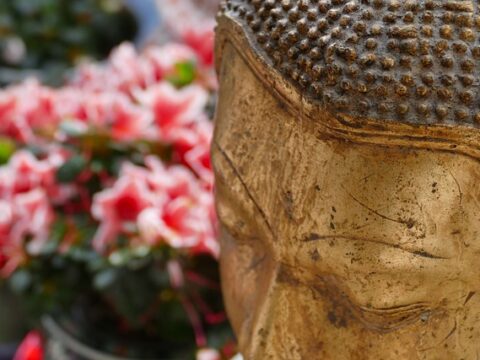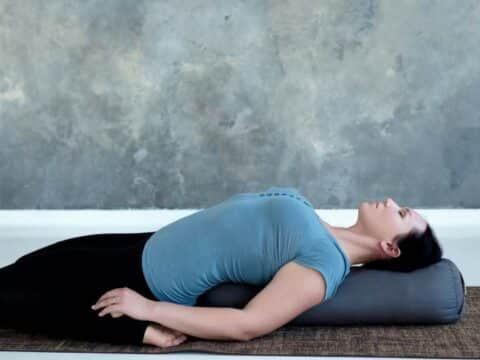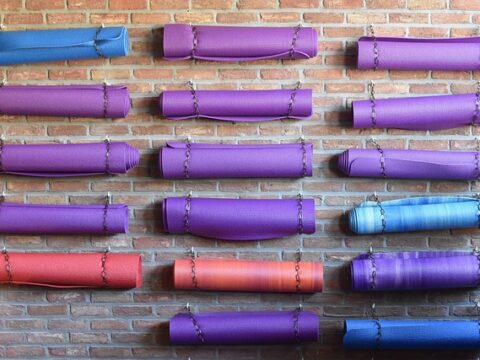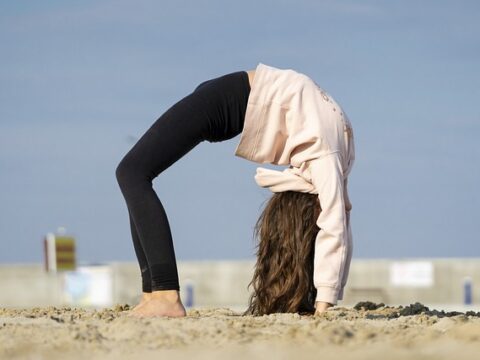The benefits of Yoga and bodybuilding go hand in hand. Yoga can help you stay healthy while bodybuilding can improve your overall body composition. Bodybuilding training involves intense workouts and rest, so it’s important to rest your muscles between each workout.
But when you’re not exercising, your muscles can’t repair themselves properly. Inactivity can slow down the recovery process.
Doing 20 to 30 minutes of Yoga on your rest day can help you warm up your muscles and get rid of metabolic waste products faster. Which means you’ll be stronger and less sore after your workout.
Video – Yoga For Bodybuilders
Podcast
In addition to improving your overall fitness, yoga can help you avoid injury. Yoga will also increase your flexibility, which is important for bodybuilders. As muscles grow, they can interfere with the body’s range of motion.
By doing yoga exercises, you’ll increase your flexibility, which will make it easier to develop your muscles.
And this will help you avoid the potential side effects of gaining muscle mass. Yoga and bodybuilding go hand in hand, so you may want to try them both out!
Can You Be A Bodybuilder And Do Yoga?
Can yoga and bodybuilding be done together? Can you do both at the same time? Is it feasible and safe? These are questions I’m going to answer for you.
Yoga takes only a few minutes. Learn how pose variety can help you break up a dull routine.
There are many ways to work yoga into your day so that it doesn’t interfere with your other plans. You can do it in the morning, around your other workouts, or at night before bed. It’s all about finding what works for you and your schedule.
Yoga and bodybuilding are mutually beneficial ways to improve your body’s health, strength, and endurance
Bodybuilding can help you strengthen your muscles, which will in turn help you build your stamina for your yoga workouts.
Yoga will help you build strength and improve your mobility and recovery time.

Common Bodybuilder Calorie Burns & Diet – Why Yoga Helps Your Digestive System/Process
The process of digestion typically refers to the breakdown of food by doctors as it travels through the gastrointestinal tract.
This includes the stomach, and your food’s components are absorbed or carried through to your colon as waste products.
However, there are several groups who say that the definition of digestion also includes symptoms such as gas, bloating, and malaise (overall discomfort) and irregularities with passing stool.
As you start to build muscle, your body will need more energy from calories and other essential nutrients to keep up with the strenuous workouts you’ll be doing from both yoga and weightlifting.
Yoga helps to alleviate or lessen many of the mild symptoms experienced with:
- General discomfort or psychological stress
- Irritable Bowel Syndrome (IBS)
- Inflammatory Bowel Disease
5 Reasons Why Bodybuilders Lose Their Gains Fast
If you begin to fit yoga and bodybuilding together without following some of the tips in this blog, you may lose your gains.
I’ve listed some of the reasons you may lose your gains (things you’ll want to avoid) when you begin to incorporate yoga and bodybuilding together into your workouts:
- You don’t train intensely enough
- You focus on too many muscle groups or too few
- You’re always changing your goalposts (maxes)
- You’re not doing enough sets
- You don’t have an effective warmup and cool down technique

Yoga & Bodybuilding: How To Maintain Your Muscle Mass
Building muscle mass is one thing. Keeping it and sculpting the powerhouse you’re looking for is yet another. Here are the most important keys to maintaining your muscle mass and keeping your body strong and fit:
- Eat clean (avoid alcohol, sugary foods, and definitely cut out deep-fried foods!)
- Ensure you get enough protein (fish, chicken, & Lentils or Pinto beans)
- Plenty of resistance training
- Drink eight full 8 ounce glasses of water per day (or more!)
- Constant & continuous workouts designed with mindfulness & muscle mass in mind
5 Best Yoga Poses For Bodybuilders
A lot of people wonder if yoga can help them build muscle. I love when people are surprised to hear that I don’t lift weights, because it’s one of the best parts of my day.
The key to gaining muscle without weights is to do the right exercises, like yoga poses, that help you push your endurance limits and break down your muscle fibers. That way, your body can build the muscle back up again.
Exercise 1: Chair Pose
The Chair Pose, also called Utkatasana in Sanskrit, is an effective way to strengthen the legs and the entire body. The Sanskrit name “utkata” means “powerful,” and “asana” means “pose.”
It’s an essential part of the sun salutation sequence and can be practiced on its own. A chair can be a great foundational yoga pose, especially for beginners who are interested in sculpting their bodies and strengthening their legs.
You’ll want your shoulder blades to slide away from your midline as you bend your arms. Make sure your arms are parallel to your torso, not up towards your ears. Your shoulder blades should slide down toward your back.
This pose mimics a lightning bolt hitting the floor. It can also be challenging for your shoulders. Beginners may need a wall to support their shoulders, but it’s possible to modify the exercise.
The Chair Pose is challenging, but it’s not impossible. The key is to find the balance between ease and effort. If you can engage the proper muscles and balance the weight evenly on each leg, you’ll be able to find stability in the posture.
So don’t be intimidated. You’ll find that practicing in a chair pose will help you stay in position and maintain balance during pregnancy. You’ll feel the benefits of the chair pose sooner than you think.
Exercise 2: Warrior 3
If you’re looking for a challenging yet rewarding yoga pose, try Warrior 3! This challenging pose helps strengthen your legs, arms, shoulders, and back muscles. It improves your balance and posture. It’s also a great way to increase your focus and concentration.
It’s an excellent pose for yoga teachers to teach because of its many benefits. Read on to discover more about this powerful posture! And don’t forget to share the benefits of this challenging pose with your students!
Warrior III’s unique design allows your toes to breathe, which helps you to get more from your workout. Instead of wearing sneakers and other footwear, this pose frees your feet from a constraint.
If your ankles are trembling, try spreading your toes wider and putting your weight into the triangle formed by your big toe, pinky toe, and heel. With practice, you will soon be able to hold Warrior III without any difficulty. Warrior III is great for strengthening your knees, too.
The Warrior III posture stretches and aligns your spine, strengthening your core, and sharpening your focus. It also creates beautiful lines in your arms and spine. Your feet, knees, and hips will all be more grounded as a result of this posture.
If you’re interested in a more challenging variation, try Yore Mi Warrior 3 or airplane pose. In either case, you’ll find the perfect pose for you!
Exercise 3: Plank
The plank pose can be an excellent exercise for beginners. It builds strength in the arms, shoulders, legs, and core. In addition to increasing strength, plank poses burn calories and boost metabolism.
In addition, planks improve overall stability. If you’re looking for a challenging yoga pose that will help you improve your posture, try a plank. But remember to take a few minutes to learn the basics.
Practicing the plank pose will help you build stamina and increase your strength in other yoga poses. A certified yoga teacher can teach you the correct technique and techniques for performing the pose.
In addition, a plank pose can help you identify which dosha dominates your body. Practice it for about 15 to 30 seconds, and then add to the length. But make sure you practice it properly! And don’t forget to breathe!
When practicing the yoga plank pose, remember to slowly build your core strength and stamina. There are several modifications of the classic yoga pose, which puts pressure on the wrists.
You can also try a forearm version if you’re not strong enough to hold it for long. Whatever type you choose, the yoga plank poses will help build stamina and strengthen your abs. You’ll feel more confident, supple, and invigorated in the long run.
Exercise 4: Dolphin Pose
This inverted posture is a good choice for those who feel unsteady in inverted positions and want to increase their self-confidence. The Dolphin Pose is also beneficial for strengthening your legs, arms, and core.
To practice it, start on all fours with your hands under your shoulders and knees under your hips. Then, lift your hips and shoulders. Lift your front and back thighs and open your hamstrings.
In the Dolphin Pose, your arms and shoulders stretch, preparing you for a more challenging inversion, called Pincha Mayurasana. It also teaches awareness and alignment, which are crucial for performing a proper inversion.
While performing this posture, your elbows should be parallel with your kneecaps and shoulders should be rolled back. As you lift your hips and head, keep your spine lengthened and your feet firmly grounded.
After practicing the Dolphin Pose, you should follow it with Downward-facing dog. Make sure not to overstretch your joints by completely straightening your legs. If you do this, your back may round, so keep your legs slightly bent.
Also, remember not to let your rib cage sink too far to the floor. To avoid overstretching, keep your shoulders firm against your back. Finally, hold your head between your upper arms and practice deep breathing.
If you have never tried a dolphin pose before, it’s probably not the best way to practice it. It’s tricky to start, and there are several variations of this posture that require a lot of practice.
To do it correctly, you should practice it four to six times a day. It’s recommended that you do this pose for thirty to sixty seconds. As you become more confident, you can move on to the next level.
Exercise 5: Haka Pose
This yoga pose is very effective in stretchin your hamstrings, and it also helps open up your hip flexors and tone your core. If you want your body to look like Adonis, then this pose is for you. Hold it for 30 seconds, and try to build up to 2 minutes.
The benefits of this basic hip opener pose are extensive. In addition to improving flexibility and mobility in the lower body, it stimulates the internal organs.
It relieves all day muscle fatigue, improves digestion, and detoxifies the body. It also increases awareness and balance. The benefits of the yoga haka pose are immense.
So, be sure to do this pose as part of your daily exercise routine. You will be glad you did.
Therapeutic Benefits of Yoga
As the popularity of mind-body fitness programs, like yoga, continues to grow, it becomes increasingly important for healthcare professionals to be knowledgeable about yoga and its many proven therapeutic benefits.
This article provides helpful information on the therapeutic effects of yoga in various populations suffering from a multitude of different ailments and conditions. Therapeutic yoga is defined as the application of yoga postures and practices to the treatment of health conditions.
Yoga therapy involves instruction in yogic practices and teachings to prevent, reduce or alleviate structural, physiological, emotional and spiritual pain, suffering or limitations.
Yoga is often sought out as a complementary therapy for mental health problems such as depression, anxiety, stress, and insomnia.
The relaxing and grounding nature of yoga can be helpful in shifting the balance from the sympathetic nervous system ( cues the body to prepare for fight-or-flight responses) to the parasympathetic nervous system ( which is calming and restorative).
Some of the ways that this calming response manifests physically are lower breathing and heart rate. Decreased blood pressure, lower cortisol levels, and increased blood flow to the intestines and vital organs.
Yoga’s main goals are to achieve tranquility of the mind, create a sense of well-being, and increase self-confidence while lowering irritability.
The practice of yoga also optimizes the body’s sympathetic responses to stressful stimuli. Reduces fear and aggression, and stimulates the pleasure centers in the median forebrain.
Yoga has been shown to be an effective tool in the management of depression. Studies have found that regular yoga practice leads to increases in serotonin levels and decreases in the levels of monamine oxidase and cortisol.
Yoga is a safe and natural way to help improve mood and reduce stress and anxiety.




